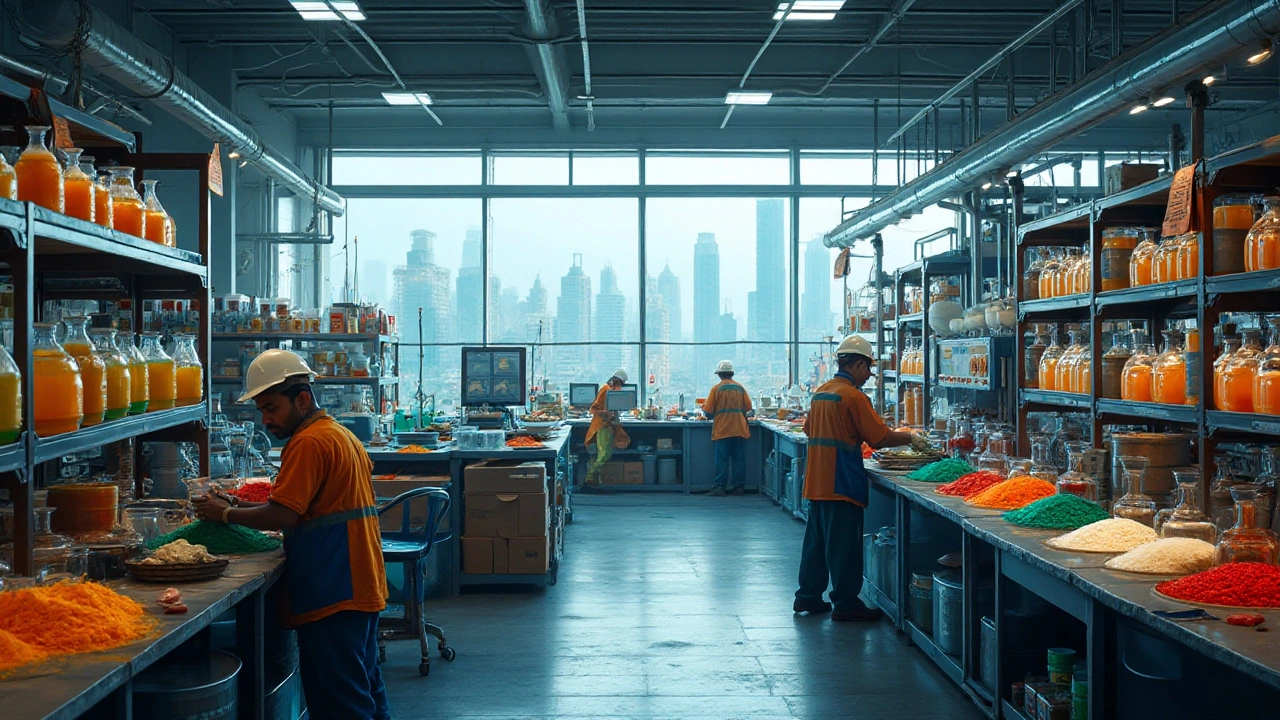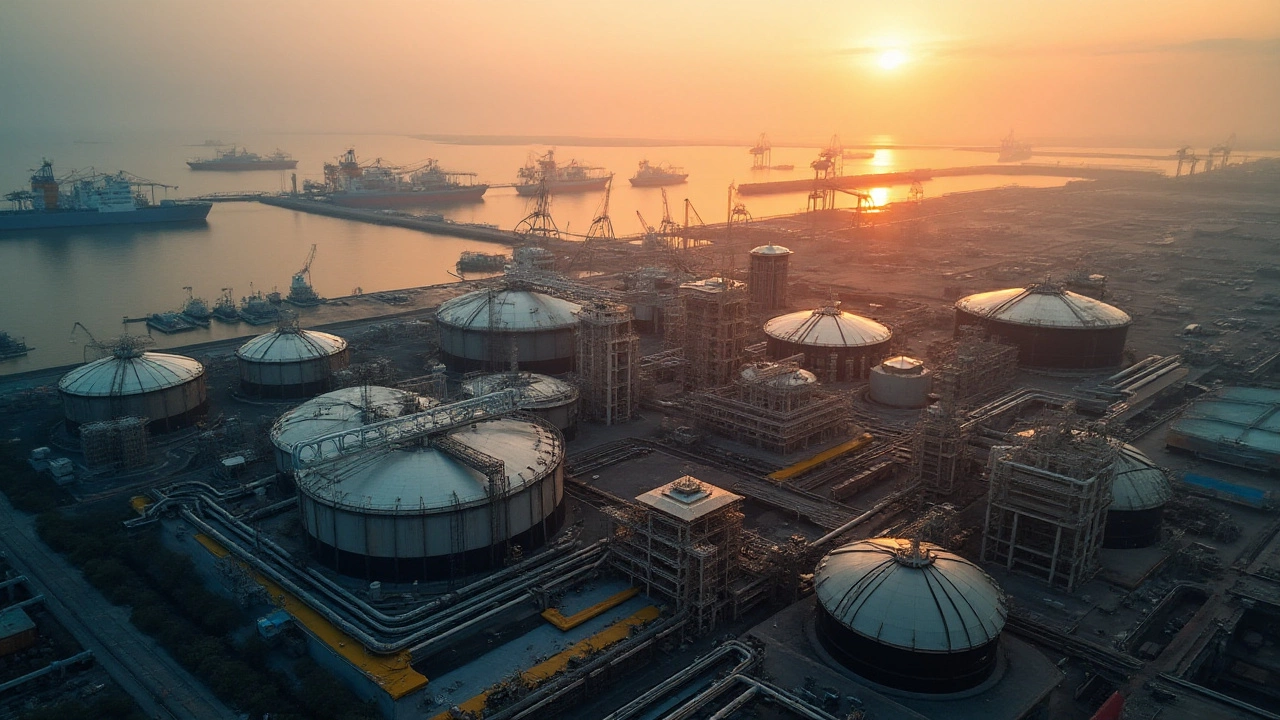 Jan, 12 2025
Jan, 12 2025
India's chemical industry has emerged as a powerhouse over the last decade, offering a multitude of opportunities for manufacturers. While the sector encompasses a wide array of products, pinpointing the most profitable ones requires a deep dive into market dynamics, consumer needs, and production efficiencies.
One would be intrigued to know how specialty chemicals have taken center stage with their customized applications, carving significant high-margin territories. Similarly, the relentless use and demand for petrochemicals in various industries make them valuable assets in the manufacturing portfolio.
Interestingly, the true art of capitalizing lies in understanding not just what is profitable, but why. It involves evaluating how raw material sourcing, labor costs, and technological advancements play into the equation. Given the right tools and knowledge, manufacturers can position themselves optimally in this competitive landscape.
As we navigate through changes in regulations, shifts in consumer behaviors, and innovations in sustainable practices, keeping an eye on future trends becomes essential. Anticipating these shifts will enable manufacturers to pivot wisely and continue thriving in this vibrant sector.
- Overview of the Chemical Industry in India
- High-Demand Chemicals in the Market
- Factors Influencing Profitability
- Strategies for Maximizing Profits
- Future Trends in Chemical Manufacturing
Overview of the Chemical Industry in India
The chemical industry in India has been a key driver of the nation's economic growth, reflecting its position as an indispensable component of the global landscape. A fascinating fusion of history, innovation, and ambition, this sector stretches back to ancient times when natural dyes and plant-based compounds laid the groundwork. Fast forward to today, and we're looking at a multi-billion dollar industry that plays a crucial role in everything from pharmaceuticals to textiles. The sector's robust growth trajectory has been powered by an abundant supply of raw materials, a skilled workforce, and expansive domestic market preferences. Notably, the government's progressive policies have also contributed to creating a conducive environment for investment and innovation.
The spectrum of chemical products coming out of India is as broad as it is impressive. The world increasingly relies on India for petrochemicals, fertilizers, plastics, and a burgeoning output of specialty chemicals. The latter, in particular, has seen tremendous growth due to its application in industries like electronics, automotive, and personal care products. Remarkably, India's chemical production index has shown an upward trend, signifying continued demand domestically and internationally. The sector's diversification has been a strategic move, enabling it to spread its wings across several continents, with Europe and North America being key trade partners.
According to a report by the Indian Brand Equity Foundation (IBEF), "The Indian chemicals industry is projected to reach $300 billion by 2025, riding on vast domestic potential and export opportunities."
Despite its impressive portfolio, the industry does not rest on its laurels. Instead, it grapples with a slew of challenges including environmental concerns, regulatory hurdles, and fluctuating raw material costs. Yet, innovation remains the cornerstone of its adaptability. Companies are increasingly investing in research and development to reduce environmental impact and enhance product efficiency. Adoption of green chemistry practices isn't just a trend, it reflects a broader commitment toward sustainability. Educational institutions and governmental bodies collaborate to drive these innovations while ensuring compliance with stringent global standards.
Chemical manufacturers in India are also investing heavily in technology, with digital transformation initiatives seeing wider implementation. This push for technology-enabled processes offers real-time monitoring and advanced analytics, boosting both output quality and efficiency. Forward-thinking strategies guided by data insights help in managing supply chain complexities and optimizing production cycles. The chemical industry in India stands at the cusp of revolution, driven by varied dynamics that each contribute towards its thriving ecosystem. As it continues to evolve, keeping pace with shifting market demands will be pivotal in maintaining its competitive edge on a global scale.
High-Demand Chemicals in the Market
The landscape of India's chemical industry is diverse and teeming with potential, especially when it comes to high-demand chemicals. These are the real drivers of growth and profitability for manufacturers. One of the most prominent categories under this umbrella is specialty chemicals. These are used in numerous industries such as automotive, aerospace, and electronics due to their unique properties that serve specific functions. Take pharmaceuticals as an example; custom-produced polymers are essential for time-release medications, creating a niche that offers sizeable margins.
Petrochemicals also stand out for their versatility and demand. As the backbone for myriad products ranging from plastics to synthetic rubber, petrochemicals see steady consumption worldwide. India, with its robust refining capacity and increasing infrastructure needs, finds a solid market for these chemicals. Interestingly, the availability of crude oil derivatives here assists in keeping production costs low, a key factor in profitability. A renowned economist once noted,
"Petrochemicals are as fundamental to the modern economy as iron and steel were to the industrial age."
Another noteworthy segment is agrochemicals. Given India's demographic tilt towards agriculture, it's no surprise that pesticides and fertilizers are in constant demand. The increasing adoption of sustainable and efficiency-centric farming practices further elevates the need for more evolved agrochemical solutions. The government's push towards doubling farm income by 2025 places immense importance on innovations within this sphere. Look for trends like bio-based agrochemicals to capture a growing market share here.
Not to be overlooked are the various base chemicals like alkalis and acids, which are indispensable across sectors such as textiles, detergents, and glass manufacturing. These rely heavily on production scale, leveraging economies that benefit from India's vast labor force and geographical advantages. With trade dynamics constantly shifting, having a diverse chemical portfolio allows manufacturers to adjust according to market demands swiftly.
As manufacturers evaluate their production lines, the keen eye is on diversifying investments across these high-demand areas. The balance lies in fostering innovation while maintaining cost efficiency, ensuring that the products not only cater to the current market but also lay the foundation for future growth.

Factors Influencing Profitability
When assessing what makes a chemical product more profitable than the next, one must look beyond just the material cost. The landscape of the chemical industry in India, as across the world, is shaped by a dynamic interplay of different factors that directly influence profitability. One such primary factor is the cost of raw materials. The fluctuations in prices of raw materials can significantly sway the profit margins of chemical manufacturers. With India relying heavily on imports for specific raw materials, global economic shifts can play a decisive role.
Another essential element is the demand and supply equilibrium. Products that see significant demand in sectors such as pharmaceuticals, agriculture, and textiles often command better prices in the market. This is where specialty chemicals enter the conversation with their ability to cater to niche markets. Their targeted uses mean that manufacturers can leverage them to fetch higher returns. Moreover, government regulations and environmental policies are pivotal in shaping the manufacturing processes as well as in directing demand towards eco-friendly alternatives.
"The future of profitability in the chemical sector will unequivocally belong to those who innovate and adapt to sustainable means," according to Anand Sharma, a noted industrial strategist.
A pivotal piece of the puzzle is technological advancement. Automation, digital transformations, and modern manufacturing techniques can burgeoning profitability by streamlining operations, reducing wastage, and improving quality consistency. For instance, integrating AI in formulation processes can aid in predicting successful chemical blends, ensuring reduced trial-and-error costs. Coupled with this is the importance of skilled labor, which remains indispensable. The availability of skilled technicians and chemists ensures that manufacturers can competently execute their operations, reducing errors and enhancing yield quality.
Distribution and logistics also potentiate the profitability equation considerably. The geographical location and proximity to end-user markets can influence costs associated with logistics significantly. As the e-commerce landscape grows, manufacturers can cut down on traditional distribution costs, opening avenues for more direct consumer interactions. Here's where leveraging technology once again offers a competitive edge. Lastly, emerging markets and untapped territories offer promising opportunities for growth. The diversification into newer markets can secure higher profits while spreading risk across different consumer bases.
Strategies for Maximizing Profits
In the bustling world of chemical manufacturing, maximizing profits requires sagacity and strategic foresight. While many factors come into play, understanding the significance of specialty chemicals in the Indian context can provide a compelling edge. Manufacturing products that align with global trends and demand ensures consistent revenue streams. Assessing market needs meticulously allows manufacturers to cater to niche markets with customized solutions, thereby increasing margins.
A pivotal strategy involves leveraging technology to enhance efficiency. By adopting state-of-the-art technology for production, companies can reduce waste and lower production costs. This is crucial in maintaining a competitive price advantage without sacrificing quality. Additionally, automation reduces dependence on manual labor, minimizing errors and speeding up the production process, thus, bolstering profitability.
Navigating the intricate maze of regulatory compliance in the chemical industry might seem cumbersome, but progressive companies see it as an opportunity to innovate. With increased scrutiny on environmental sustainability, organizations focusing on green manufacturing processes not only meet regulations but also resonate with conscious consumers. By investing in sustainable practices, companies build trust and enhance their brand image, which can translate into premium pricing strategies.
Optimizing Supply Chains
Another area that presents abundant opportunities for profit maximization is optimizing the supply chain. Effective supply chain management minimizes disruptions, ensuring the smooth flow of goods from production to customer delivery. Diversifying supply sources can mitigate risks associated with reliance on a single supplier, safeguarding against supply chain shocks. Enhancing logistics through the use of digital platforms aids in real-time tracking, and responding to issues promptly ensures efficiency.
Strong partnerships with reliable suppliers and distribution networks can exponentially increase profit margins. By negotiating favorable terms and bulk purchasing of raw materials, manufacturers can diminish costs. Additionally, maintaining robust relationships with distributors guarantees access to wider markets, amplifying sales opportunities significantly.
"Success in chemical manufacturing is not just about understanding reactions; it's about being reactive to market demands and proactive in innovations," intricate yet precise words articulated by Dr. R. Ganesh, a leading industry expert. His insight highlights the importance of agility and creativity in this space.
Data-Driven Decisions
By harnessing data analytics, a manufacturer can make informed decisions to drive profitability. Through rigorous analysis of market trends and consumer behaviors, companies can anticipate demand shifts and tailor their production schedules accordingly. This precise forecasting avoids overproduction and stocks of stagnant inventory, which can drain resources and profits.
Moreover, understanding consumer behavior on a granular level allows for effective marketing strategies designed to penetrate new segments.Indian manufacturers are increasingly leveraging data analytics to develop innovative ways of reaching out to customers, ensuring their products are top of mind when purchasing decisions are made. The ability to personalize marketing efforts based on detailed customer insights offers an advantage over competitors operating in the same space.
Lastly, investments in upskilling the workforce cannot be overstated. A well-trained and knowledgeable workforce is crucial for maintaining high production standards. By focusing on continuous improvement and education, companies ensure employees are equipped to handle industry advancements capably, driving manufacturing excellence and ultimately resulting in increased profits.

Future Trends in Chemical Manufacturing
The landscape of chemical manufacturing is on the brink of transformation, driven by rapid advancements in technology and shifting market demands. One of the most significant developments reshaping the sector is the march toward sustainable and green chemistry. As environmental awareness grows, there's an amplified focus on reducing carbon footprints, and this has catapulted the demand for biodegradable products and eco-friendly processes. With increasing regulations in place, manufacturers are urged to innovate ways that not just meet compliance but set new standards in sustainability.
Another trend gaining momentum is digitalization within the industry. From AI-driven analytics to smart manufacturing processes, digital transformation is optimizing operations while reducing costs. Predictive maintenance of machinery through IoT devices and big data analytics is curtailing downtimes and improving efficiency across production lines. This technological prowess enables companies to make informed decisions swiftly, adapt to changes in demand, and offer personalized solutions to customers.
Interestingly, according to a recent study by the Federation of Indian Chambers of Commerce & Industry (FICCI), by 2027, the Indian chemical industry is expected to double its current valuation driven by these advancements and growing domestic consumption. Specialty chemicals, with their application-specific formulation, are poised to lead the charge, aligning with the global push for products tailored to distinct needs. Industry leaders believe that innovation in this domain could propel India's position as a global hub for chemical industry solutions.
Additionally, the integration of biotechnology in the production processes is a notable trend. Bio-based chemicals are not only offering sustainable alternatives but are enabling the development of superior products. Cultured from biological materials, these chemicals inherently reduce dependency on fossil fuels, aligning with global sustainability targets and opening new revenue streams for innovative manufacturers.
As Anand Mahindra, Chairman of Mahindra Group once aptly put, "The future belongs to the curious, the ones who are not afraid to try it, explore it, poke at it and turn it inside out." This curiosity and willingness to innovate are what will steer the chemical industry of tomorrow.
With India holding a critical position as a supplier to the world, investing in R&D and embracing these future-forward trends can empower its manufacturing capabilities. As these trends continue to evolve, companies that leverage them effectively are likely to secure a steadfast position in the international market, driving profitability and supporting sustainable economic growth.